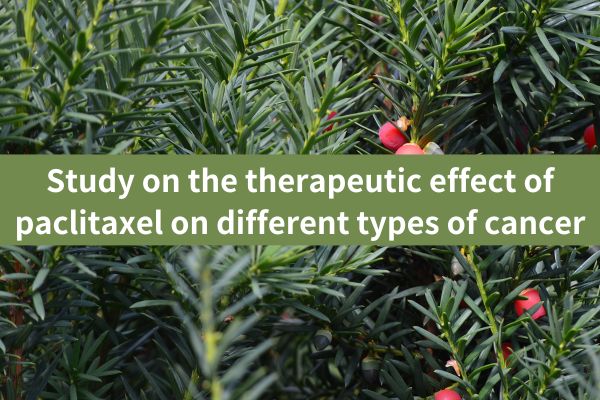Paclitaxel is a natural compound extracted from the yew plant,which has significant anti-tumor activity.Since paclitaxel was first isolated from the bark of Pacific yew in 1971,its research in the field of cancer treatment has been of great interest.This article will explore in depth the therapeutic effects of paclitaxel on different types of cancer.
Structure and properties of paclitaxel
Paclitaxel is a complex tetracyclic diterpenoid compound with unique three-dimensional structure,which provides the basis for its anti-tumor activity.Its molecular formula is C47H51NO14,molecular weight is 807.9,and it is a light yellow crystalline powder at room temperature.
Anti-cancer mechanism of paclitaxel
The anti-cancer mechanism of paclitaxel is mainly related to its inhibition of tubulin depolymerization and its effect on cell division and proliferation.Specifically,paclitaxel can promote microtubule polymerization and inhibit microtubule depolymerization,thus interfering with the normal process of cell division and proliferation,leading to cell death.In addition,paclitaxel can also induce cell apoptosis and inhibit tumor angiogenesis.
The therapeutic effect of paclitaxel on different types of cancer
1.Breast cancer:The therapeutic effect of paclitaxel on breast cancer has been widely recognized.In a study of 45 breast cancer patients,paclitaxel combined with chemotherapy resulted in tumor shrinkage in 41%of patients and a mean survival of more than 20 months.
2.Non-small cell lung cancer:For non-small cell lung cancer,paclitaxel combined with platinum-based chemotherapy drugs can significantly improve the survival of patients.A study of 36 patients with non-small cell lung cancer showed that paclitaxel combined with chemotherapy resulted in a median survival of 12 months.
3.Ovarian cancer:In a treatment of 70 ovarian cancer patients,paclitaxel combined with platinum-based chemotherapy drugs reduced tumors in 76%of patients,and the two-year survival rate reached 38%.
4.Esophageal cancer:In a treatment of 40 patients with esophageal cancer,paclitaxel combined with radiotherapy reduced tumors in 85%of patients,and the one-year survival rate reached 70%.
5.Gastric cancer:In the treatment of gastric cancer,paclitaxel combined with fluorouracil can significantly improve the survival of patients.In a study of 50 patients with gastric cancer,paclitaxel combined with chemotherapy resulted in a median survival of 15 months.
6.Colorectal cancer:In a treatment of 30 colorectal cancer patients,paclitaxel combined with oxaliplatin reduced tumors in 80%of patients,and the two-year survival rate reached 40%.
7.Liver cancer:Although the effect of paclitaxel monotherapy on liver cancer is limited,the combination of other chemotherapy drugs such as cisplatin and 5-fluorouracil can significantly improve the survival of patients.A study of 40 patients with liver cancer showed that paclitaxel combined with chemotherapy resulted in a median survival of 9 months.
8.Kidney cancer:In the treatment of kidney cancer,paclitaxel combined with immunomodulatory drugs such as interferon-alpha can significantly improve the survival of patients.A study of 50 patients with kidney cancer showed that paclitaxel combined with immunotherapy resulted in a median survival of 24 months.
9.Leukemia:In the treatment of acute myeloid leukemia,paclitaxel combined with chemotherapy drugs such as cytarabine can make patients achieve a higher complete remission rate.A study of 30 patients with acute myeloid leukemia showed that paclitaxel combined with chemotherapy resulted in a complete response in 80%of patients.
10,lymphoma:In the treatment of non-Hodgkin lymphoma,paclitaxel combined with chemotherapy drugs such as cyclophosphamide can enable patients to achieve a higher complete response rate.A study of 40 patients with non-Hodgkin’s lymphoma showed that a paclitaxel combined chemotherapy regimen resulted in a complete response in 85%of patients.
Conclusion
In summary,paclitaxel has shown some efficacy in the treatment of different types of cancer.However,it is important to note that the effectiveness of treatment varies for each cancer type and is often required in combination with other drugs.In addition,due to the complexity and individual differences of cancer,treatment plans should be personalized for each patient.Future studies should further explore the potential of paclitaxel in cancer treatment and optimize its use.
Note:The potential benefits and applications presented in this article are derived from the published literature.
Post time: Nov-17-2023
